These resources are from an archived version of our website. Want to see what we’ve been up to lately? Check out our new website.
Let light in: Six ways to build your home for optimal sun
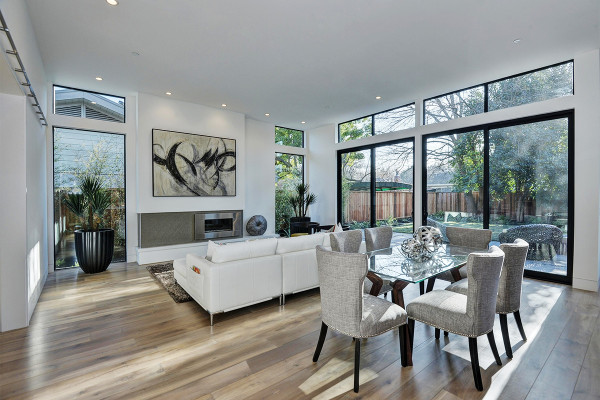
On average, Palo Alto sees 261 sunny days each year – about 30 percent more than the average American city. It’s no doubt that this weather motivates Silicon Valley residents to get outside. But the sunlight also benefits you indoors – as long your home is built strategically.
The truth is, natural light is a key element to any modern home. In contrast to harsh and distracting artificial lamps, modern homes intentionally bring in optimal levels of natural light, enhancing the comfort and beauty of the living space.
At Clarum, we encourage our clients to think about natural light throughout the homebuilding process. Read more about the benefits of natural light, and how you can maximize sun in your home!
The benefits of natural light
Studies show that incorporating natural light into architecture provides key benefits for residents. Beyond the beauty of an airy, well-lit space, natural light increases productivity and comfort. It even helps to regulate human circadian rhythms – and who couldn’t use a solid night’s sleep?
Natural light can also lead to substantial energy savings. According to the U.S. Department of Energy, fifteen percent of all electricity generated in the United States goes toward lighting – but when your home relies on the sun instead of artificial lamps, you reduce this consumption. Additionally, homes oriented toward the sun (without any additional solar features) save between 10 – 20 percent on heating costs. With this data, it’s no doubt that relying on natural light is valuable for residents and the environment alike.
Maximizing natural light in your home
It’s clear that natural light benefits the environment, your well-being, and even your finances – but the next step is to take action. Are you thinking about natural light strategically as you build your dream home? Below are our tips to build a home that leverages light to its fullest potential:
Orient your home toward the sun
Design your home so that frequently-used rooms (such as the living room or the kitchen) receive an ample amount of sunlight. Also take into consideration which rooms don’t require a lot of extra light, such as the garage or the laundry room – and design your floor plan accordingly.
Unsure of which direction each room should take? Use this cheat sheet to help you consider where to orient each room in your modern home:
- South-facing rooms allow most winter sunlight, but little direct sun during the summer.
- North-facing rooms admit relatively even, natural light, and almost no unwanted summer heat.
- East-facing rooms receive the most morning sun. Locating the dining room or breakfast nook on an east wall makes the most of light potential in the morning. It’s also a good place for a dense floor that can soak up some solar heat. Bedrooms with east-facing windows will be great for early risers, but terrible for people who like to sleep in.
- West-facing rooms collect early evening light. Because the sun is so low in the sky, west-facing windows get direct sunlight blazing through them. This makes them a bad choice for TV rooms, since strong light makes screens harder to see.
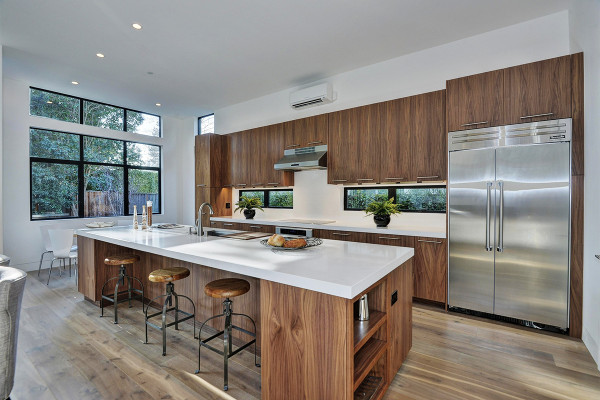
Consider the seasons
Once you understand the sun’s path and how to orient your home accordingly, the next step is to think about other factors, such as the time of year and positioning of your home.
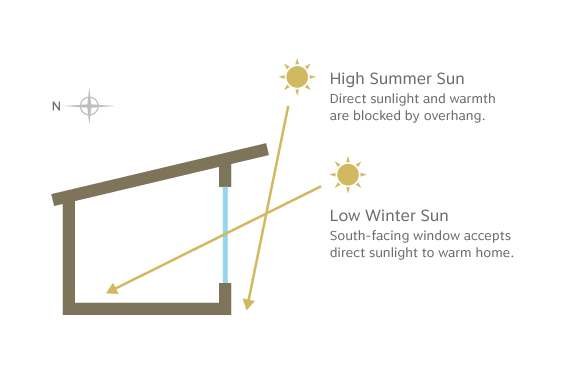 Consider the sun’s location during different seasons, as illustrated in the above diagram. In summer, when the sun is high and warm, you may want to consider overhangs to shade your home. In contrast, the low, winter sun can shine below these overhangs to allow you to still benefit from their warmth.
Consider the sun’s location during different seasons, as illustrated in the above diagram. In summer, when the sun is high and warm, you may want to consider overhangs to shade your home. In contrast, the low, winter sun can shine below these overhangs to allow you to still benefit from their warmth.
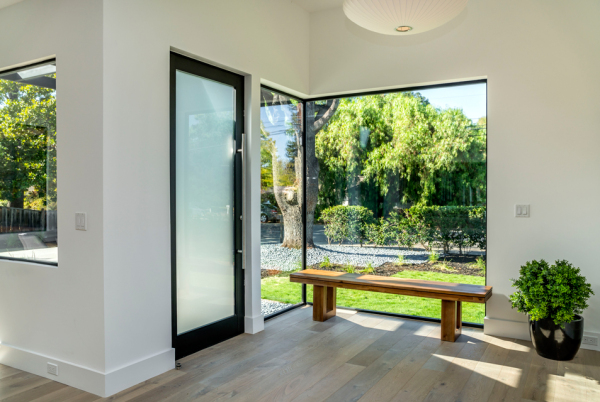
Be strategic with shading
Overhangs can help in any season, but you can find other ways to strategically shade your home all throughout the year. Work with your builder to incorporate trees or exterior walls/fences to minimize unwanted sunlight. Additionally, structural additions such as a porch, trellis, or simple window coverings can also provide the relief you’re looking for.
The good news is you don’t need to sacrifice style for shade. Look for modern ways to provide a relaxing environment, like trellises with natural materials or translucent screens.

Rely on light interiors
One of the easiest ways to maximize natural light in your home is to incorporate light-colored shelves and lighter interior coloring. Pale and neutral colors ensure maximum reflection value throughout the home, and make each room seem even brighter.
To couple this strategy with a modern look, consider an all-white palette for your living space. White interiors and finishings pair well with big windows, natural light, and the airiness of expansive rooms – further enhancing the beauty of your modern home.
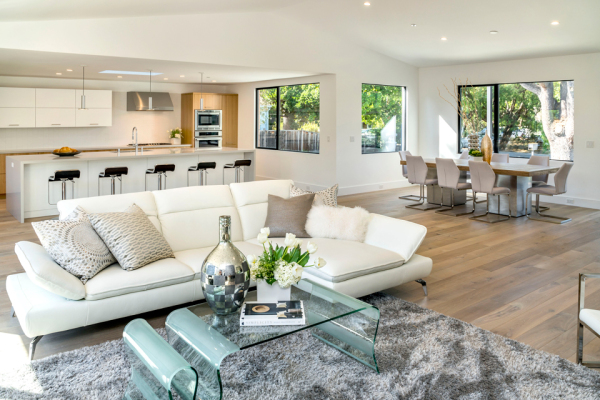
Embrace daylighting techniques
Expert homebuilders embrace daylighting: the strategic placement of windows and skylights to effectively bring sunlight into your home. The science of daylighting design goes beyond providing enough light into a specific space. It also involves balancing heat gain and loss, glare control, and variations in daylight availability.
In the end, successful daylighting takes an integrated approach to design. Work with your custom homebuilder to make daylighting decisions surrounding building form, siting, climate, and components such as windows and skylights.

Communicate with your homebuilder
The best way to ensure optimum sunlight is to communicate with your expert builder throughout the home-building process. At Clarum, we leverage our expertise and pair it with the elements of modern design to provide the levels of light you’re looking for. Your builder can work with you to pair natural-lighting techniques with your personal style – it’s one of the countless benefits of custom homes!

Live on the bright side
Natural light enhances the beauty and comfort of your home – and when incorporated into your design process, it can provide serious value and benefits to you as a homeowner.
Want to learn more about how Clarum can help you build the modern home of your dreams? Give us a call at 650.322.7069.








